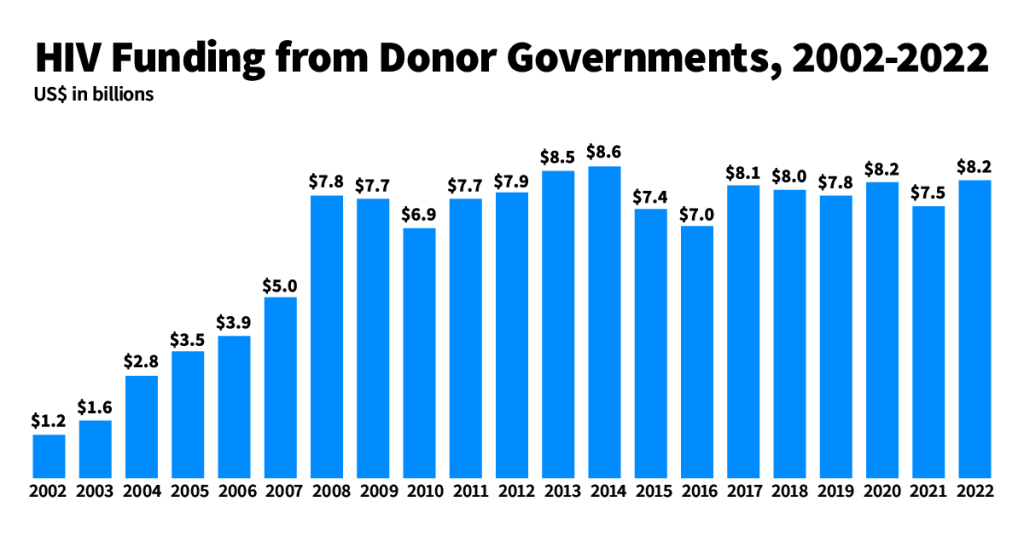[ad_1]
A new report from KFF and The Joint United International locations Programme on HIV/AIDS (UNAIDS) finds that donor governments dispensed US$8.2 billion in 2022 to battle HIV in low- and middle-income nations, returning to 2020 investment ranges and nonetheless underneath the high-water mark of $8.6 billion in 2014. The investment helps HIV care and remedy, prevention, and different products and services in low- and middle-income nations.
Even if overall donor executive investment for HIV larger in 2022 in comparison to the yr sooner than, this build up used to be basically as a result of the timing of U.S. bills fairly than larger donor executive commitments.
Whilst there was important growth in addressing the HIV epidemic—there have been 1.3 million new infections in 2022, down from roughly 2 million a decade in the past, and nearly part as many AIDS-related deaths—new infections and AIDS-related deaths are on the upward thrust in some areas, together with in Japanese Europe and Central Asia and the Heart East and North Africa. Additional, greater than 9 million other people dwelling with HIV nonetheless lack get admission to to antiretroviral remedy.

The U.S. is still the biggest donor to HIV, offering 74% of all donor executive HIV investment (US$6.1 billion), adopted via France (5%, US$382 million), the UK (5%, US$376 million), the Ecu Fee (4%, US$328 million), and Germany (2%, US$191 million). The U.S. additionally ranked first when standardized via the dimensions of its economic system, adopted via the Netherlands, France, Sweden, and Denmark.
“UNAIDS information display obviously that growth in opposition to finishing AIDS is the most powerful within the nations that experience essentially the most monetary investments,” mentioned Winnie Byanyima, Govt Director of UNAIDS. “As of late, global leaders are confronted with an exceptional alternative to finish AIDS via 2030. On the other hand, globally in 2022, investment used to be just about US$ 9 billion in need of the USA$ 29.3 billion wanted via 2025. Via making an investment now, donors won’t best push ahead the top of AIDS however can also be higher ready for long run pandemics.”
“Our research displays that donor executive investment for HIV is solid however stagnant, with present ranges underneath the high-water mark reached nearly a decade in the past,” KFF Senior Vice President Jen Kates mentioned. “This contributes to uncertainty forward, specifically in mild of falling home sources.”
Donor governments’ bilateral support—supplied immediately to or on behalf of explicit nations fairly than to multilateral organizations—used to be US$5.6 billion in 2022, an build up of virtually US$130 million in comparison to 2021 (US$5.5 billion), basically as a result of the timing of U.S. bills.
General bilateral investment from donor governments, rather then the US, has lowered every yr for greater than a decade (via nearly US$1.4 billion or 80% since 2011). Whilst will increase in multilateral investment have offset those declines in some years, total investment from those donor governments remains to be greater than US$1.0 billion underneath the place it used to be simply over a decade in the past.
The document, “Donor Government Funding for HIV in Low- and Middle-Income Countries in 2022” is a part of a collaborative monitoring effort between UNAIDS and KFF that started nearly two decades in the past, simply as new world tasks had been being introduced to handle the epidemic. The research comprises information from all 31 contributors of the Organisation for Financial Co-operation and Building (OECD)’s Building Help Committee (DAC), in addition to non-DAC contributors who document information to the DAC.
The knowledge incorporated on this document also are incorporated in a broader UNAIDS world document, which examines all resources of investment for HIV aid, together with native governments, non-governmental organizations, and the non-public sector.
[ad_2]
Source link

